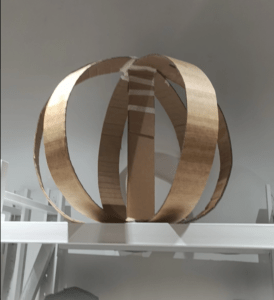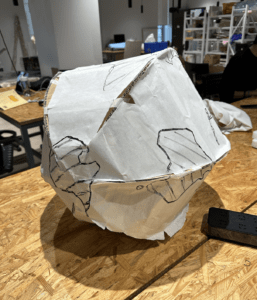The title of our performance is called “The Earth”. The idea was from one of our group member’s device for “The Plague”, and frankly the biggest reason we chose it was because it’s the easiest thing we could make out of cardboards and the demonstration would also be the most suitable for on-stage performance among all the ideas we’ve came up with. 
It took us approximately two days to make the prop. We first made one using a structure shown in the picture here, but because that day only me and two other members were available, so we utilized the Cardbaord Workshop and spent an afternoon making this piece. But then we realized this structure isn’t supportive enough can’t really maintain a sphere shape, so I proposed an idea using round-shaped boards pieced together to make the inner structure of our “earth”, which then turned out looking something like this in the second photo. This one is the one we eventually used for the performance. 
I think our performance went very well. I was one the people holding up our “earth” and making sure it keeps spinning and changing the velocity of the spin according to the plot of our performance. Honestly it was a bit tiring to hold it up through out the whole thing haha, but I think the most difficult part in the performance are not us who were holding the “earth” but the two members who needed to recite all the dialogs. We had a talented member in our group who really have the gift for writing play scripts, and she basically came up with the whole thing herself based on the story “The Plague”. It was wonderfully written, and from the reaction of the audience and the feedback from professors, I could tell it was a marvelous script.
I remember professor Eric asked us what is the interactiveness to this device. Actually I had the same concern when I was reading the script, since the mast obvious interaction in the performance was between the two talking characters instead of with the “earth”. Though I quickly realized that there were interactions between human and the device when one of the character was moving and adding “glowing figures” to the “earth”, and thus changes the velocity of the spin of the glob, but maybe if we were to make any improvement of our performance, we could make it more obvious to the audience, whether though a change in out movements or a change of plot.
One of the performance of another group that left me a deep impression was the group after us, Group G, whose title was “Hypersomniac 2000”. They combined the function of the device with our students’ daily life which made the performance much more relatable and humorous, and my favorite thing about this group was their diversity in prop. Their cardboard prop was simple, but it was big and somewhat colorful, which makes it more memorable. And besides the Cardbaord, they also used coffee cups, blanket and pillow, and even a glass of water used to splash onto one of the members face. It was hilarious. They really did a great job on the word “performance”, as I find them to be the most entertaining group.
After finishing the performance and looking back, the hardest thing of this group work was probably finding time slots where everyone would be available. That’s the case for most group works, and with members from different year, our schedules were very different which made it even harder. Even the first meeting we only manage to get four of us. But what we did was to have several people to work on different tasks or parts asynchronously instead of having everyone together at the same time so we could all make best use of our time.
Here’s the script of our group and the video link to our performance for you to enjoy : )
Here are the perspective links:
https://drive.google.com/file/d/1WcbhAROWoFxxmESrgT4pI3uFyLdyfUOQ/view?usp=share_link
https://drive.google.com/file/d/1Lpz6KezxyRDnNFKalaaKllS-Ziqtzfr3/view?usp=share_link